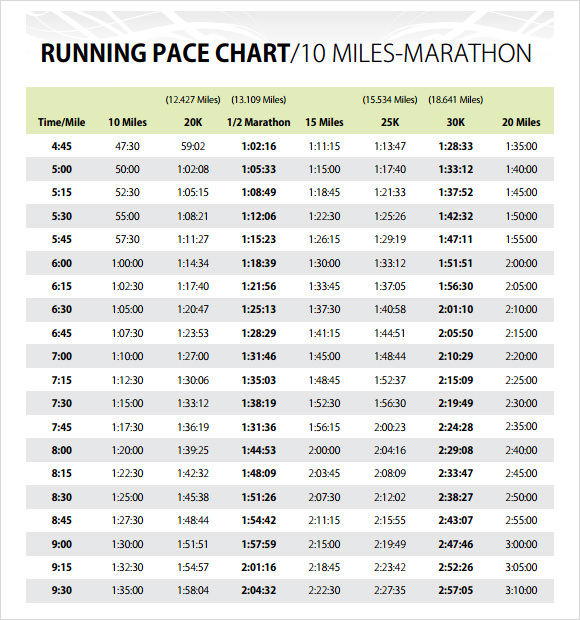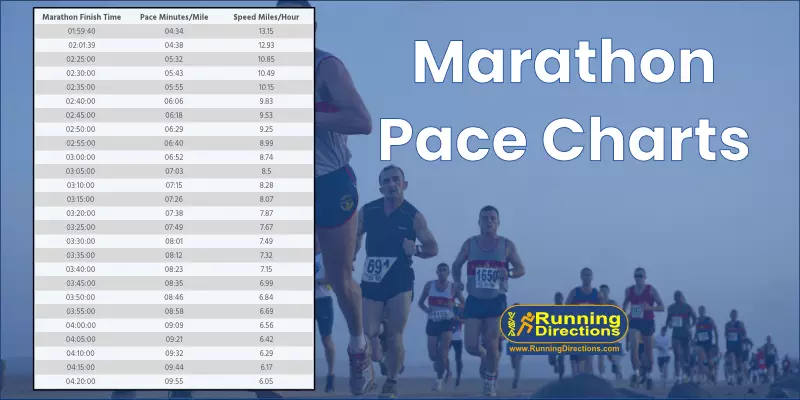Understanding Marathon Pace and Its Importance
Marathon pace refers to the average pace a runner maintains throughout a 26.2-mile race. It is a crucial factor in long-distance running, as maintaining a consistent marathon pace can significantly impact overall performance and race outcomes. A marathon pace calculator is a valuable tool for runners, as it helps them determine their ideal marathon pace based on factors such as recent race times, training runs, and personal goals.
Using a marathon pace calculator can help runners optimize their training and race strategies by providing insights into their target marathon pace. This, in turn, allows them to design effective training plans that incorporate workouts and long runs at their projected marathon pace. By practicing at their target marathon pace during training, runners can improve their race-day performance and increase their chances of achieving their goals.
How to Use a Marathon Pace Calculator Effectively
A marathon pace calculator is an essential tool for runners preparing for a long-distance race. To use a marathon pace calculator effectively, follow these steps:
- Gather your recent race results or time trial data. Ideally, you should have a recent 5K, 10K, or half-marathon time to input into the calculator. This data will help the calculator estimate your potential marathon pace.
- Choose a reputable marathon pace calculator. Some popular options include the ‘McMillan Running Calculator‘ and ‘Runner’s World Smart Coach’. These tools provide accurate estimations based on your input data and consider various factors that influence marathon pace.
- Enter your data into the calculator. Input your recent race time, age, gender, and any other requested information. Make sure to double-check the data before calculating your marathon pace.
- Review the results. The calculator will provide an estimated marathon pace based on your input data. Analyze the results and consider how they align with your personal goals and expectations.
- Incorporate the calculated marathon pace into your training plan. Use the estimated marathon pace to guide your workouts and long runs. Practice maintaining this pace during training to improve your race-day performance.
When using a marathon pace calculator, remember that the results are estimates based on your input data. Factors such as fitness level, running history, age, gender, and race conditions can influence your actual marathon pace. Always consider these factors when interpreting the results and setting your race goals.
Factors Influencing Marathon Pace
Various factors can influence your marathon pace, and it is essential to consider these when using a marathon pace calculator and setting your race goals. Some of these factors include:
- Fitness level: Your current fitness level plays a significant role in determining your marathon pace. Regular training, including strength and endurance workouts, can help improve your overall fitness and enable you to maintain a faster pace during the race.
- Running history: Your running history, including previous race experiences and personal bests, can also impact your marathon pace. Experienced runners with a solid running history may have a better understanding of their capabilities and can set more accurate marathon pace goals.
- Age: Age can affect your marathon pace, as older runners may experience a decline in speed due to natural physiological changes. However, this does not mean that older runners cannot achieve fast marathon times with proper training and pacing strategies.
- Gender: Gender can also influence marathon pace, as men typically have a faster average marathon pace than women. However, individual abilities and training progress should always be the primary factors in setting marathon pace goals.
- Race conditions: Weather, elevation changes, and course terrain can all impact your marathon pace. Be prepared to adjust your pace based on the specific race conditions you will encounter on race day.
When using a marathon pace calculator, consider these factors and input accurate data to ensure the results align with your individual abilities and race goals. By taking these factors into account, you can set realistic marathon pace goals and optimize your training and race strategies.
Setting Realistic Marathon Pace Goals
Setting realistic marathon pace goals is crucial for optimizing your training and achieving a successful race performance. To set realistic marathon pace goals, consider the following tips:
- Assess your current fitness level: Evaluate your current running abilities, including your recent race times, training volume, and overall fitness level. This information will help you determine a realistic marathon pace based on your individual abilities.
- Analyze your training progress: Review your training logs and progress over time. If you have been consistently improving your pace and endurance, you may be able to set more ambitious marathon pace goals. However, be cautious not to set goals that are too aggressive, which could lead to overexertion or underperformance.
- Consider your race goals: Determine your overall race goals, such as finishing the marathon, achieving a personal best, or qualifying for a specific event. Your marathon pace goals should align with these broader objectives.
- Use a marathon pace calculator: A marathon pace calculator, such as the ‘McMillan Running Calculator‘ or ‘Runner’s World Smart Coach’, can help you estimate a realistic marathon pace based on your input data. Make sure to consider the factors influencing marathon pace, such as fitness level, running history, age, gender, and race conditions, when using the calculator.
- Balance ambition and caution: Set marathon pace goals that challenge you but are also achievable given your current fitness level and training progress. Aim for a pace that allows you to complete the marathon comfortably while still pushing your limits.
By setting realistic marathon pace goals, you can optimize your training, avoid overexertion or underperformance, and achieve a successful race performance.
Incorporating Marathon Pace into Training
Integrating your target marathon pace into your regular training routines can help you become more comfortable with the pace and improve your overall race-day performance. Consider the following suggestions for incorporating marathon pace into your workouts and long runs:
- Marathon-pace workouts: Schedule workouts that focus on maintaining your target marathon pace. These workouts can include intervals, tempo runs, or fartleks at your marathon pace. By practicing marathon pace during structured workouts, you can build confidence and familiarity with the pace.
- Long runs at marathon pace: Incorporate long runs at or near your target marathon pace into your training plan. These runs can help you build endurance and improve your ability to maintain the pace throughout the marathon. Start by running a portion of your long run at marathon pace, gradually increasing the duration as your fitness improves.
- Marathon-pace simulations: Simulate race-day conditions by practicing your marathon pace during long runs or workouts that mimic the course profile, weather conditions, or time of day you will encounter during the race. This can help you become more accustomed to running at your target marathon pace under various circumstances.
By incorporating marathon pace into your training, you can improve your ability to maintain the pace during the race and enhance your overall marathon performance.
Monitoring Progress and Adjusting Marathon Pace
Tracking your progress and adjusting your marathon pace as needed is crucial for optimizing your training and achieving your race goals. Utilize data from races, time trials, or regular runs to inform pace adjustments and monitor changes in your fitness level and training volume. Consider the following tips when monitoring progress and adjusting your marathon pace:
- Regular assessments: Schedule periodic assessments of your running performance, such as time trials or regular runs at a set distance, to track your progress over time. Use this data to adjust your marathon pace goals and training strategies as needed.
- Race data analysis: Analyze your race data, including splits and finish times, to identify areas for improvement and adjust your marathon pace goals accordingly. For example, if you notice that you tend to start too fast and fade in the later stages of a marathon, consider adjusting your pace strategy to incorporate a more conservative start and a stronger finish.
- Adapt to changes in fitness level: As your fitness level improves, you may be able to maintain a faster marathon pace. Regularly re-evaluate your marathon pace goals based on your current fitness level and training progress.
- Consider individual factors: Factors such as age, gender, running history, and race conditions can all influence your marathon pace. Be prepared to adjust your marathon pace goals and strategies based on these individual factors.
By monitoring your progress and adjusting your marathon pace as needed, you can optimize your training and improve your chances of achieving your race goals.
Marathon Pace Strategies for Different Race Scenarios
Selecting the right marathon pace strategy can significantly impact your race performance. Various strategies, such as even splits, negative splits, or pace bands, can be employed based on individual strengths, weaknesses, and goals. Consider the following advantages and disadvantages of each strategy and how to choose the best one for your unique situation:
- Even splits: Running even splits involves maintaining a consistent pace throughout the entire marathon. This strategy can help minimize the risk of burnout or exhaustion in the later stages of the race. However, it may not be the best option for runners who tend to start too fast or struggle with maintaining a steady pace.
- Negative splits: A negative split strategy involves running the second half of the marathon faster than the first half. This approach can help runners conserve energy in the early stages of the race and finish strong. However, it requires discipline and patience, as runners must resist the temptation to start too fast.
- Pace bands: Pace bands are tools that help runners maintain a consistent pace throughout the marathon. They typically display target splits for each mile or kilometer based on the runner’s goal pace. Pace bands can be helpful for runners who struggle with pacing or need a visual reminder of their target pace. However, they should be used in conjunction with other pacing strategies, as relying solely on a pace band can lead to disappointment if external factors, such as weather or course conditions, impact race pace.
When choosing a marathon pace strategy, consider your individual strengths, weaknesses, and goals. Experiment with different strategies during training to determine which one works best for you. By selecting the right marathon pace strategy, you can optimize your race performance and achieve your goals.
Mental Techniques for Maintaining Marathon Pace
Mental preparation plays a crucial role in maintaining a consistent marathon pace during the race. Utilize the following mental techniques to help you stay focused and on track:
- Set intermediate goals: Break the marathon into smaller segments, such as miles or kilometers, and set specific goals for each segment. This approach can help you maintain focus and motivation throughout the race, as you will have a series of short-term objectives to work towards.
- Use positive self-talk: Speak positively to yourself during the race, focusing on your strengths and abilities. Encouraging self-talk can help you overcome mental barriers and maintain a consistent marathon pace, even when the going gets tough.
- Manage race-day nerves: Develop strategies for managing race-day nerves, such as deep breathing exercises, visualization techniques, or progressive muscle relaxation. By reducing anxiety and stress, you can maintain a more consistent marathon pace and enjoy a more positive racing experience.
- Stay present: Focus on the present moment rather than dwelling on the past or worrying about the future. By staying present, you can better respond to the demands of the race and maintain a consistent marathon pace, even when faced with unexpected challenges or obstacles.
By incorporating mental techniques into your marathon training and racing, you can improve your ability to maintain a consistent marathon pace and achieve your race goals. Remember, mental preparation is just as important as physical preparation when it comes to long-distance running success.









